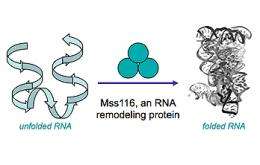Evolutionarily young protein helps ancient RNA get into shape

(PhysOrg.com) -- Scientists once believed that proteins govern most cellular activities. However in recent years scientists have found that a diverse group of RNA molecules regulate numerous biological activities. Despite their ancient origin, these RNA molecules have come to rely on younger protein partners to carry out their functions.
In the Oct. 13 online issue of the journal Nature, scientists at Yale and Wayne State University show how a complex of RNA and proteins work together symbiotically to help a big RNA adopt its proper shape.
"The process of RNA folding is crucial to understanding many processes such infection by viruses that have an RNA genome, such as Hepatitis C, or West Nile Virus," said Anna Marie Pyle, the William Edward Gilbert Professor of Molecular Cellular and Developmental Biology, professor of chemistry and co-senior author of the paper.
In old textbooks, RNA was viewed simply as the chemical intermediary between DNA’s instruction manual and the creation of proteins. But in the human genome, for instance, only about 2 percent of our 3 billion genetic letters encode for protein-producing genes. Much of the rest contain recipes for different RNAs that rearrange, activate or turn off many of those genes.
“The vast majority of our DNA does not encode proteins after all; rather it encodes RNA,” said Pyle, who is also a researcher for the Howard Hughes Medical Institute. “RNA is far more important in biology than any of us imagined even five years ago, and we need to understand its structure."
Pyle’s lab is interested in a particular type of large, catalytic RNAs known as group II introns, which are involved in splicing of genes and other RNAs. The Yale and Wayne State team showed in the Nature paper that the yeast protein Mss116 plays a key role in helping group II introns, and other RNAs, adopt their proper shape.
The interaction between a group II intron RNA and the Mss116 protein is an interesting example of how an RNA molecule, which existed long before it ever encountered the protein, has evolved to collaborate with its more modern protein cousin to regulate its activity, notes Pyle.
“Now more than ever, we must understand the many processes involved in RNA function and how protein molecules facilitate them,” Pyle said.
Provided by Yale University


















